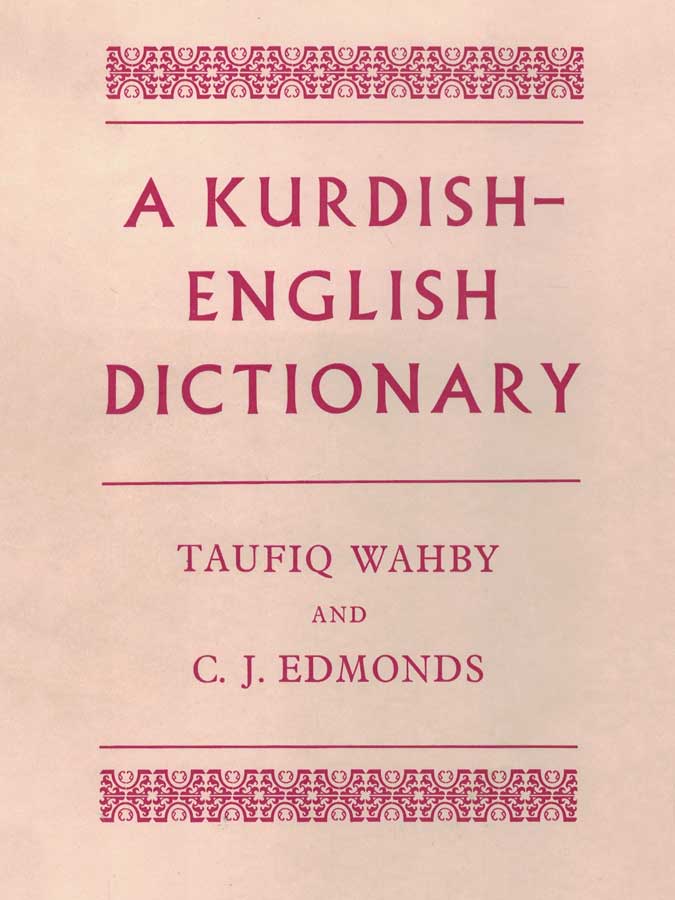واتای «e» لە فەرهەنگی وەهبی و ئەدمۆندزدا:
-e [1]
vocative ending: kuṟe: boy!
-e [2]
defining suffix also used:
(1) in conjunction with demonstrative adjectives em, ew, e.g. em kuṟe: this boy, ew kiche: that girl, ew suwarane: those horse-men, (for exceptions see em, ew);
(2) with diminutive or affectionate connotation, especially in the shortened forms of personal names and nicknames, e.g. Bile for Ibrahîm.
If the noun defined ends in û euphonic w, and if in any other vowel euphonic y is inserted before -e;
this -e attracts the stress
Compare -eke1 and -eke2
-e [3]
used
(1) to replace îzafe (y2) when the phrase is qualified by a defining suffix or demonstrative adjective, the phrase being then treated as a compound noun e.g.
minaḻ y zîrek: clever child
—minaḻe zîrekeke: the clever child
—em minaḻe zîreke: this clever child;
(2) to replace îzafe to link a permanent epithet to the noun it qualifies, e.g.
kêl y shîn: blue upright stone, makes kêleshîn: name of a stele with cunei-form inscription on the Iraqi-Persian boundary;
(3) in general as a link in the formation of many compound nouns e.g.:
deskeguḻ: bunch of flowers, posy;
ṟesheba: black wind, gale;
pîremêrd: old man.
If the first element of a compound so formed ends in û euphonic w, and if in î euphonic y, is inserted before the linking e;
if it ends in a, e, ê, o, or ö, the linking e is absorbed so as to leave the second element in direct juxtaposition with the first, e.g. ga y bor makes gaboreke: the brown ox.
-e [4]
suffix used in the formation of:
nouns from nouns, e.g. anîshk: elbow — anîshk-e: bracket;
nouns from adjectives e.g. chak: good — chake: kind act;
nouns from nouns qualified by a numeral adjective e.g. chilṟoje: period of forty days;
and nouns from verbal roots e.g. kêshan: draw — kêshe: toil
-e [5]
3rd person singular present indicative of the copula is;
euphonic w and y are inserted as for -e2.
e- [6]
particle prefix to present and imperfect indicative tenses of most verbs
Compare de2, y-3
e [7]
emphasizing particle placed before pronouns and demonstrative adjectives and attracting the stress, e.g.:
e min: I;
e to: you;
e ewe: just that;
e êre: just here;
e em baxe: this very orchard.
e [8]
preposition to;
generally enclitic immediately following a verb;
also used to introduce nouns used predicatively;
in conjunction with postposition -ewe: into.
Examples:
ewan geyishtin e koshkeke: they reached the mansion
minaḻeke binêrin e debistan: send the child to school
ebêt e piyaw: he will become a man
echêt e eshkewteke’we: he goes into the cave;
euphonic w and y are inserted as for -e2.
see ê5 and tê for the circumstances in which they replace e.
e [8]
preposition is prefixed to certain nouns, generally nouns of place, to form compound prepositions;
the noun governed is not linked to the compound preposition by îzafe (y2);
some of these are used in conjunction with postposition -ewe as indicated after each below:
ebaḻ: upon (ḍan ebaḻ: attribute to)
eban: upon
eber: to the front of, towards,
(ḍan eber: attack with, e.g.
min-yan ḍa yeber cinêw: they reviled me;
•piyaweke eḍat eber xencer: he attacks the man with a dagger)
•ebin (-ewe): to belowegiyan: generally kewtin egiyan: attack
ejêr (-ewe): to below, to under
ejûr (-ewe): on to, over
(xistin ejûr ... -ewe: give precedence over)
ekin (-ewe): to the side of
enaw (-ewe): into
epaḻ (with or without -ewe), to the side of
epash (-ewe): to the rear of, until after
epêsh (with or without -ewe), to the front of
(ḍan epêsh xo: drive something forward)
episht (with or without -ewe), to behind
eser: upon, on to
eshön: after, in search of
etek: to the side of (with or without -ewe)
exuwar (-ewe): to beneath, under
‛e
interjection shepherd’s cry urging flocks forward

بەرهەمی:
تۆفیق وەهبی و ئەدمۆندز
زمان:
کوردیی ناوەندی بۆ ئینگلیزی
ساڵی بڵاوبوونەوە:
1966